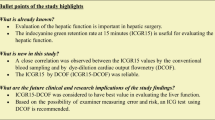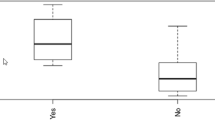Abstract
Background
For a safe major hepatectomy, preoperative methods that can reliably estimate postoperative liver function are necessary. The aim of this study was to assess the utility of ICG-R15 measured by pulse dye densitometry to predict residual liver function prior to hepatectomy.
Patients and method
In 29 patients who underwent various types of hepatectomies, indocyanine green (ICG)-R15 was measured by pulse dye densitometry at the time of opening the abdomen (laparotomy phase), clamping the Glisson’s pedicles to cutting (clamping phase), and closing abdomen after hepatectomy (resection phase). The relationships among these measurements and postoperative liver function were examined.
Results
The mean ICG-R15 was 12.3 ± 6.0% preoperatively (±SD), 9.3 ± 7.0% at laparotomy, 18.8 ± 11.6% at clamping, and 20.1 ± 10.9% at resection. The preoperative and laparotomy and the clamping and resection ICG-R15 values correlated significantly. Eleven (38%) patients developed postoperative hyperbilirubinemia [total bilirubin (T-Bil) >3.0 mg/dl]. The postoperative peak T-Bil correlated significantly with clamping ICG-R15 (r = 0.637, p = 0.0002), but not with preoperative ICG-R15 (r = 0.283, p = 0.137), total clamp time (r = 0.005, p = 0.975), and blood loss (r = 0.097, p = 0.615). Multivariate analysis identified ICG-R15 measured at clamping as the only determinant of postoperative peak T-Bil (r = 0.612). ICG-R15 measured at clamping correlated with the postoperative hospital stay (p = 0.046).
Conclusions
ICG-R15 can be measured in real time during surgery by pulse dye densitometry. ICG-R15 measured by this technique before hepatectomy provides a direct and reliable measure of postoperative residual liver function, thus helping in surgical decision making regarding the extent of hepatectomy.




Similar content being viewed by others
References
Fan ST, Lo CM, Liu CL et al (1999) Hepatectomy for hepatocellular carcinoma: toward zero hospital deaths. Ann Surg 229:322–330
Lai EC, Fan ST, Lo CM et al (1995) Hepatic resection for hepatocellular carcinoma. An audit of 343 patients. Ann Surg 221:291–298
Mullin EJ, Metcalfe MS, Maddern GJ (2005) How much liver resection is too much? Am J Surg 190:87–97
Poon RT, Fan ST, Lo CM et al (2002) Extended hepatic resection for hepatocellular carcinoma in patients with cirrhosis: is it justified? Ann Surg 236:602–611
Gill RA, Goodman MW, Golfus GR et al (1983) Aminopyrine breath test predicts surgical risk for patients with liver disease. Ann Surg 198:701–704
Lau H, Man K, Fan ST et al (1997) Evaluation of preoperative hepatic function in patients with hepatocellular carcinoma undergoing hepatectomy. Br J Surg 84:1255–1259
Pearl RH, Clowes GH Jr, Bosari S et al (1987) Amino acid clearance in cirrhosis. A predictor of postoperative morbidity and mortality. Arch Surg 122:468–473
Clowes GH Jr, McDermott WV, Williams LF et al (1984) Amino acid clearance and prognosis in surgical patients with cirrhosis. Surgery 96:675–685
Irving CS, Schoeller DA, Nakamura KI et al (1982) The aminopyrine breath test as a measure of liver function. A quantitative description of its metabolic basis in normal subjects. J Lab Clin Med 100:356–373
Sugimoto H, Okochi O, Hirota M et al (2006) Early detection of liver failure after hepatectomy by indocyanine green elimination rate measured by pulse dye-densitometry. J Hepatobiliary Pancreat Surg 13:543–548
Yamanaka N, Okamoto E, Oriyama T et al (1994) A prediction scoring system to select the surgical treatment of liver cancer. Further refinement based on 10 years of use. Ann Surg 219:342–346
Midorikawa Y, Kubota K, Takayama T et al (1999) A comparative study of postoperative complications after hepatectomy in patients with and without chronic liver disease. Surgery 126:484–491
Hemming AW, Scudamore CH, Shackleton CR et al (1992) Indocyanine green clearance as a predictor of successful hepatic resection in cirrhotic patients. Am J Surg 163:515–518
Okamoto E, Kyo A, Yamanaka N et al (1984) Prediction of the safe limits of hepatectomy by combined volumetric and functional measurements in patients with impaired hepatic function. Surgery 95:586–592
Okochi O, Kaneko T, Sugimoto H et al (2002) ICG pulse spectrophotometry for perioperative liver function in hepatectomy. J Surg Res 103:109–113
Leevy CM, Smith F, Longueville J et al (1967) Indocyanine green clearance as a test for hepatic function. Evaluation by dichromatic ear densitometry. JAMA 200:236–240
Niemann CU, Roberts JP, Ascher NL et al (2002) Intraoperative hemodynamics and liver function in adult-to-adult living liver donors. Liver Transpl 8:1126–1132
Fan ST, Lai EC, Lo CM et al (1995) Hospital mortality of major hepatectomy for hepatocellular carcinoma associated with cirrhosis. Arch Surg 130:198–203
Wu CC, Ho WL, Lin MC et al (1998) Hepatic resection for bilobar multicentric hepatocellular carcinoma: is it justified? Surgery 123:270–277
Ozawa K (1990) Hepatic function and liver resection. J Gastroenterol Hepatol 5:296–309
Schneider PD (2004) Preoperative assessment of liver function. Surg Clin North Am 84:355–373
Sasaki N, Shiomi S, Iwata Y et al (1999) Clinical usefulness of scintigraphy with 99 mTc-galactosyl-human serum albumin for prognosis of cirrhosis of the liver. J Nucl Med 40:1652–1656
Kwon AH, Ha-Kawa SK, Uetsuji S et al (1995) Use of technetium 99 m diethylenetriamine-pentaacetic acid-galactosyl-human serum albumin liver scintigraphy in the evaluation of preoperative and postoperative hepatic functional reserve for hepatectomy. Surgery 117:429–434
Hwang EH, Taki J, Shuke N et al (1999) Preoperative assessment of residual hepatic functional reserve using 99mTc-DTPA-galactosyl-human serum albumin dynamic SPECT. J Nucl Med 40:1644–1651
Fujioka H, Kawashita Y, Kamohara Y et al (1999) Utility of technetium-99m-labeled-galactosyl human serum albumin scintigraphy for estimating the hepatic functional reserve. J Clin Gastroenterol 28:329–333
Lam CM, Fan ST, Lo CM et al (1999) Major hepatectomy for hepatocellular carcinoma in patients with an unsatisfactory indocyanine green clearance test. Br J Surg 86:1012–1017
Yamanaka N, Okamoto E, Kato T et al (1992) Usefulness of monitoring the ICG retention rate as an early indicator of allograft function in liver transplantation. Transplant Proc 24:1614–1617
Koneru B, Leevy CB, Klein KM et al (1994) Clearance of indocyanine green in the evaluation of liver donors. Transplantation 58:729–731
Tsubono T, Todo S, Jabbour N et al (1996) Indocyanine green elimination test in orthotopic liver recipients. Hepatology 24:1165–1171
Ohwada S, Kawate S, Hamada K et al (2006) Perioperative real-time monitoring of indocyanine green clearance by pulse spectrophotometry predicts remnant liver functional reserve in resection of hepatocellular carcinoma. Br J Surg 93:339–346
Iijima T, Aoyagi T, Iwao Y et al (1997) Cardiac output and circulating blood volume analysis by pulse dye-densitometry. J Clin Monit 13:81–89
Miyoshi H, Umeshita K, Sakon M et al (1996) Calpain activation in plasma membrane bleb formation during tert-butyl hydroperoxide-induced rat hepatocyte injury. Gastroenterology 110:1897–1904
Belghiti J, Noun R, Malafosse R et al (1999) Continuous versus intermittent portal triad clamping for liver resection: a controlled study. Ann Surg 229:369–375
Author information
Authors and Affiliations
Corresponding author
Rights and permissions
About this article
Cite this article
Akita, H., Sasaki, Y., Yamada, T. et al. Real-Time Intraoperative Assessment of Residual Liver Functional Reserve Using Pulse Dye Densitometry. World J Surg 32, 2668–2674 (2008). https://doi.org/10.1007/s00268-008-9752-0
Published:
Issue Date:
DOI: https://doi.org/10.1007/s00268-008-9752-0




